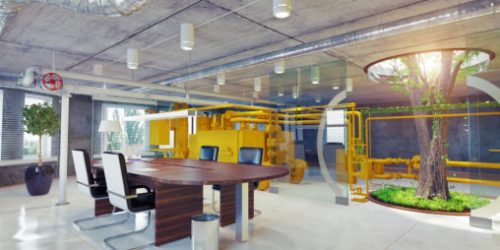What new uses are there for office spaces?
Flex office, teleworking, co-working… Many new working habits are revolutionising the traditional use of office spaces. Since it is no longer necessary to go to the company’s premises every day to work, what new uses are there for office spaces today?
Long before the health crisis, a study by the real estate consulting firm JLL, published in 2018, already indicated a continuous increase in the share of flexible offices in the overall European tertiary real estate stock. During the 5 years preceding the study, this proportion had increased from 25 to 30% each year, reaching 5% of the European tertiary real estate stock.
The Covid-19 epidemic has further accentuated this trend. Although teleworking and home office are popular with employees, companies are increasingly considering the flex office as a solution of the future. As early as 2016, a Cushman & Wakefield study showed that 89% of large European companies were testing or planning to introduce different flexible working environments. In 2018, this underlying trend was confirmed by another survey, conducted jointly by Savills and Workthere, which predicted an increase in the share of flex offices by 15% in the medium term, and 25% in the long term, in the 20 main European cities. Although the new post-Covid European data on flex offices is not yet available, it is a safe bet that these already very promising forecasts have been sharply revised upwards.
Meeting the need for flexibility
The evolution of workspaces should not only respond to a company’s concern to save money. Many other parameters come into play. Flexibility at work has become popular among employees who, for the most part, do not consider going back in terms of their working conditions. On a global scale, some 73% want their employer to maintain flexible working practices in the post-Covid world, according to another survey carried out in 2020 by Cushman & Wakefield.
It is now possible to choose between working from home, in co-working space or in a regular office. This new flexibility clearly raises the question of the definition of the workspace. What obligation requires employees to go to their company’s premises every day? Which workspace should be favoured to concentrate, to interact with colleagues, or to consult about a project? Which locations and what organisation of space should be favoured to create the conditions for well-being and a quality of life at work conducive to employee commitment and productivity? In short, what is the raison d’être of the office today, and what should be its added value?
A place for meetings and interaction
With the effect of teleworking and collaborative tools, the workspace is dematerialised. According to various studies, remote work also increases employee productivity and commitment. In fact, the idea of a dedicated workstation in the company’s premises is becoming obsolete due to the growing success of the flex office. Faced with these developments, one of the intangible functions of office spaces is clear: that of a place of sociability, meetings and interactions.
Offices are called upon to become collaborative hubs, where employees come to meet their colleagues, participate in work meetings, or attend the most important presentations. The physical workspace becomes that of the embodiment of corporate identity. As underlined by Ludovic Delaisse, Managing Director of Cushman & Wakefield France, specialist in real estate management of professional spaces: “It is the company’s lungs, where the richness of social interaction is concentrated”. More than ever, the office is becoming the emblem of a corporate culture, a place of social cohesion around which the feeling of belonging crystallises. It also showcases the company, as it is the space where visitors are received. This is why it is essential today to make office spaces friendly, modular and multi-use. In the era of flex office and teleworking, there is no longer any sense in organising most of your premises in an open space format. Reception rooms, meeting rooms, cafeterias, places to concentrate, but also to relax between two productive work sessions, these are the new uses to be reserved for professional premises.
Attracting talent
More than ever, office spaces must demonstrate their added value compared to other workspaces, such as remote working or co-working. There is an issue of cohesion, but also of attractiveness to enable the company to attract new talents. From this point of view, the company’s premises greatly contribute to the success of an employer brand. For an equivalent position and salary, it’s a safe bet that, between two companies, candidates will choose the one which, in addition to offering them the possibility of teleworking, will also make them want to work in its premises, because they knows that they will feel good there, that they will work efficiently, and that interactions with their colleagues will be rewarding. Even more so than in the past, office space is becoming the emblem of a company’s success. The important thing is no longer that it is able to accommodate all the employees at the same time, but that it entices them, and makes them proud and happy to work for this company.






